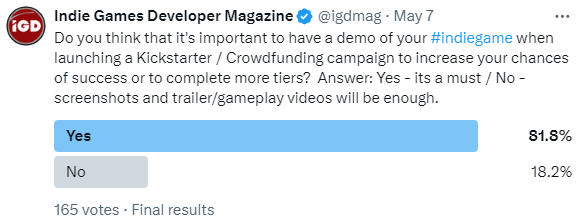Embarking on a Crowdfunding Campaign is both exhilarating and challenging, yet with careful preparation, you can alleviate much of the stress involved. Rushing into it hastily is ill-advised; take the time to lay the groundwork.
Before you begin
Start by thoughtfully crafting your campaign page down on paper or in a document, ensuring it’s equipped with all of the necessary content elements such as logos, graphics, videos, and, most importantly, compelling information about your game and its objectives.
Ensuring realistic goals and support tiers is paramount. When dealing with projects involving physical items, it’s essential to consider all associated costs, such as production and delivery expenses. Overlooking these details may result in unexpected charges like international shipping and customs fees, potentially draining your core funds allocated for game development.
Pre-launch
Prior to launching, it is important to build up a following for your campaign. Launching with zero followers drastically diminishes the likelihood of reaching your target goal. Unless you’re confident in the immediate support of your existing social media audience backing your campaign from the get-go, then some groundwork will need to be done.
Campaign followers are more inclined to pledge support compared to social media followers, owing to increased visibility. Not everyone sees social media posts due to platform algorithms. Converting social media followers to crowdfunding backers will require some time and a little patience, as not all will immediately pledge their support.
Launching
There’s nothing quite like the anticipation of launching your crowdfunding campaign, only to realise you’ve overlooked something or made a mistake. It’s crucial to double-check everything before hitting that go-live button!
Hopefully, by now, you’ve amassed a substantial following to provide initial backing and generate momentum for your campaign. Additionally, having a solid marketing strategy in place is essential for sustained progress. If not, it’s imperative to focus on building your follower base, adjust any timelines accordingly, and then proceed with the launch.
Despite time constraints or other challenges, persevering remains a viable option, though it demands substantial effort to guarantee visibility and the potential for your campaign to achieve viral status, seizing the right opportunities for broader coverage. However, it also entails a heightened risk of failure.
Nonetheless, even if your primary goal is achieved, reaching the desired level for additional tiers might prove challenging without that initial building up of followers, so please reconsider your options. If you are more than ready, it’s time to move forwards with your campaign.
Midway Decline
An observed trend in crowdfunding campaigns, including those we’ve marketed, is a visible decline in momentum halfway through or upon nearing the initial target goal. Several factors contribute to this trend: waning campaign visibility due to slowed marketing efforts, content oversaturation, or diminishing urgency among potential backers as the project nears its conclusion.
When faced with this scenario, consider boosting your marketing efforts with fresh, engaging content. Additionally, utilizing platforms with active communities that can help drive additional traffic to your campaign.
Mere posts in promotion-friendly communities might not suffice; collaboration for extended reach may entail up-front costs. Ideally, you should establish these connections way before launching to capitalize on the initial or ongoing momentum.
Keep in mind that community engagement strategies may take time to yield results (up to two weeks) even if posts appear in timelines or notifications. It’s a crucial aspect worth anticipating.
One of the most important things to consider when promoting your campaign within communities is not to spam or abuse the rules set out for you. This will annoy the owners/moderators and could end up reducing your overall visibility when you need it the most.
Race to the finish line
This is when you need to push the hardest, especially if you’re feeling burned out and exhausted from your marketing efforts. Give it one last strong effort towards the end goal. By the halfway point of your campaign, you’ll have a good sense of whether it will succeed.
If it looks uncertain, it may be time to rethink your marketing strategy. Often, failure stems from a lack of experience and preparation.
Each campaign serves as a learning opportunity, with your first one providing invaluable experience necessary to ensure the success of future campaigns. Ideally, thorough preparation will negate the need for such reliance on past experiences.
Taking a break
Take some time to reflect and recharge before devising a plan to allocate your campaign funds effectively. Even if your campaign was not a success, this step is crucial. Reflecting on what went wrong and planning your next steps can provide valuable insights and help you identify areas for improvement. Properly directing your resources towards key areas of development will enhance your chances of completing your game and achieving better results in the future.
Other things to consider;
Preparing a Demo
Preparing a demo of your game can significantly boost your chances of a successful campaign, provided your game is polished and not barebones. We also believe that if your game is about a year away from completion, your backers will be happy. Any longer than that, and they may start to worry about whether the game will ever be finished.
To back this up, we gathered insights from our community by conducting two polls – one on Twitter/X (primarily catering to Indie Game Devs) and another within our LinkedIn group (comprising of 39% Game Industry professionals at the time of polling completion, the remainder in Software/Entertainment/Other). Though this represents a small segment, we contend that it is reasonable to assume that even with a substantial increase in votes, the outcome would remain largely consistent.
Regular Communication
Regularly keeping your backers and followers informed can help maintain their support and extend this timeline, but it can also take you away from development. Therefore, it’s important to have someone dedicated to handling updates and communication while you focus on completing your game.
In Summary
- Before you begin: Meticulously plan your campaign page with all necessary elements and realistic goals.
- Pre-launch: Build a following to ensure campaign visibility and convert social media followers into backers.
- Midway Decline: Combat declining momentum with fresh marketing content and community engagement.
- Race to the finish line: Push hardest towards the end, reassessing strategies if success seems uncertain.
- Taking a break: Reflect and recharge before planning the allocation of campaign funds and learning from the experience.
Important factors to consider;
- Preparing a Demo: Ensure you have a polished game demo to instil confidence in backers about your project’s completion.
- Regular Communication: Keep backers informed regularly, balancing updates with game development.
We trust that the guidance we’ve shared, drawn from our experience and observations, while not exhaustive, will aid you in sidestepping potential pitfalls and laying the groundwork for success from the outset. Remember, every campaign scenario is unique, but we hope these insights will offer valuable direction nonetheless. Best of luck with your ongoing or forthcoming campaign!
Resources that we provide to help you further:
Join our Community
Submit your Game
















